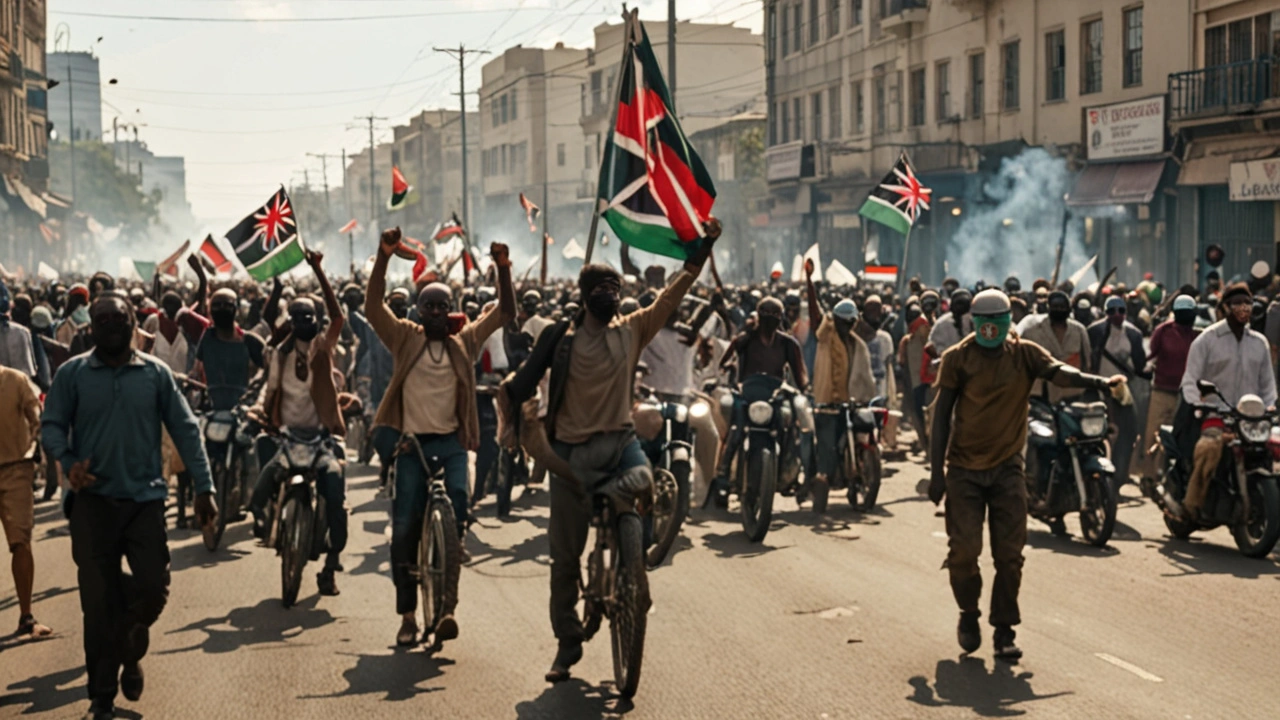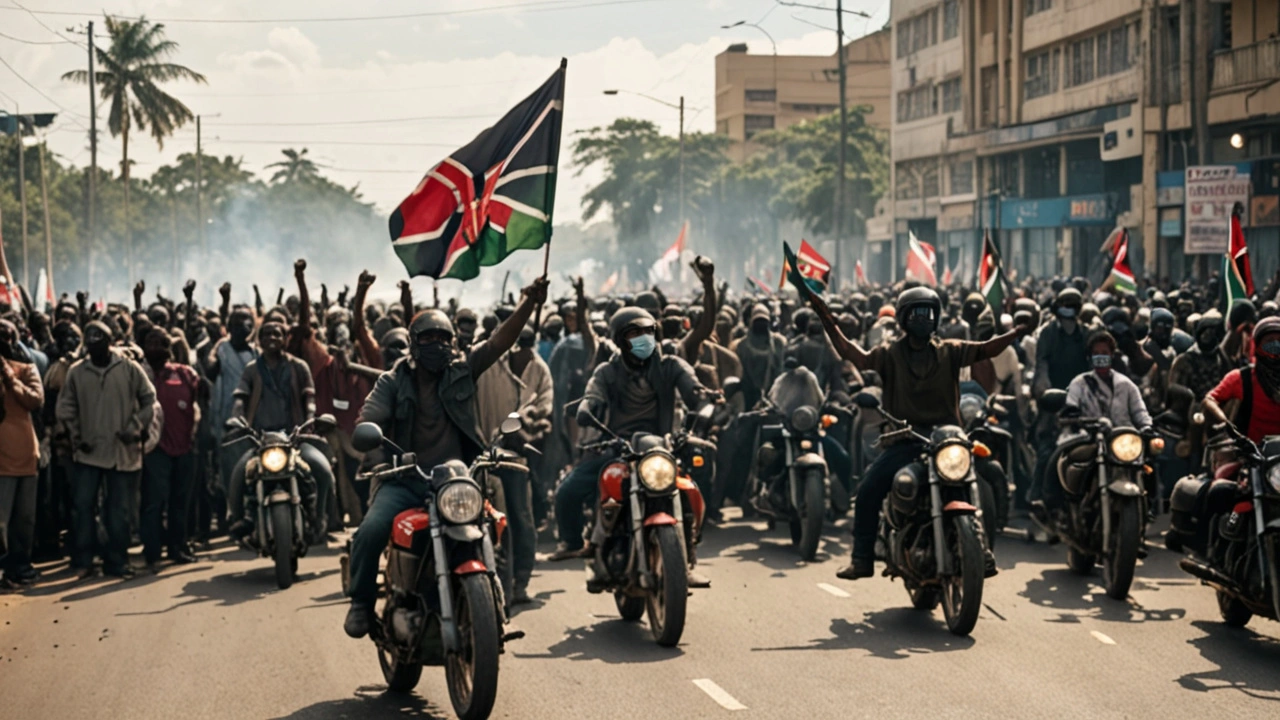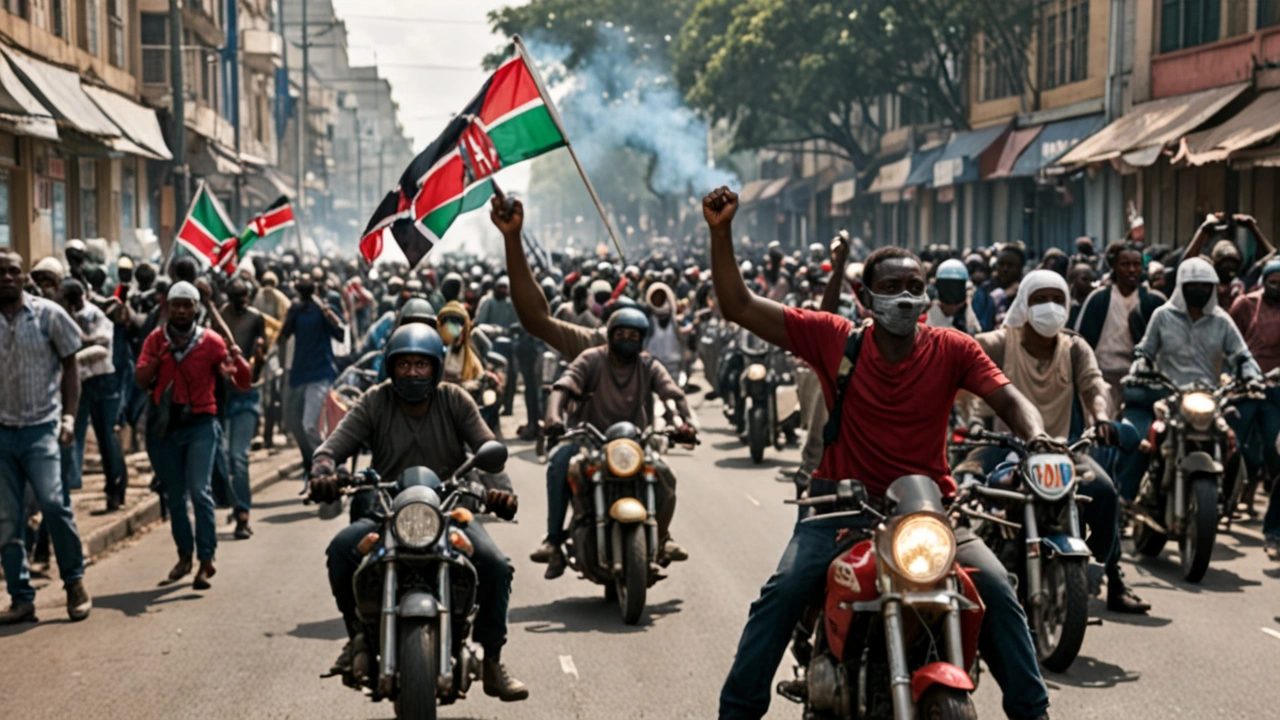Kenya Protests Intensify: Tear Gas Deployed as Demonstrators Demand President Ruto's Resignation
The atmosphere in Nairobi, Kenya's vibrant capital, took a tumultuous turn as thousands of demonstrators gathered to voice their dissatisfaction with President William Ruto's administration. The passionate cries for the president to step down echo through the city streets, revealing the intense frustration and discontent brewing among the citizens. The demonstration, organized by prominent opposition figures, has escalated into a significant movement, earning the label of a 'total shutdown' that has disrupted daily life.
With protestors marching and chanting, the air grew thick with tension. Security forces were quickly dispatched to manage the swelling crowds. In their efforts to disperse the demonstrators, police turned to tear gas, a move that only heightened the chaos. The scenes were fraught with skirmishes between protestors and law enforcement, as tear gas canisters arched through the air, releasing plumes of smoke that stung the eyes and throats of those within its range.
The Root of the Unrest
The roots of this unrest can be traced to numerous grievances held by the public. Critical issues at the forefront include economic hardships and alleged governmental mishandling. President Ruto's administration has faced intense scrutiny over its economic policies, which many argue have exacerbated poverty and unemployment rates. Citizens, particularly those from marginalized communities, feel the brunt of these issues, fueling their fervent demand for change.
Organizers of the protest allege that corruption within the government is rampant, further straining the nation's resources and widening the gap between the wealthy and the impoverished. This, coupled with alleged electoral malpractices during the last elections, has reduced public trust in the government and its leaders, including President Ruto.
A Call for Change
The call for President Ruto to step down is not merely a demand for a change in leadership – it represents a broader plea for systemic reforms. Protestors are urging for policies that prioritize the well-being of the average citizen, with a particular focus on reducing poverty and creating job opportunities. They demand transparency and accountability from their leaders, yearning for a government that truly serves its people's needs.
The declaration of a 'total shutdown' by protest organizers was meant to underscore the severity of their demands and the extent of their discontent. The widespread participation in the protests, which stretched beyond Nairobi to other regions of the country, signifies a unified stance against the current administration. Streets that are usually bustling with activity now lie eerily quiet, as shops and businesses shutter their doors in solidarity with the demonstrators' cause.

Escalating Violence and Its Implications
As the protest continues, the potential for escalating violence remains a significant concern. Clashes between protestors and police have already led to injuries, and there are fears that the situation could deteriorate further. In some areas, reports of looting and vandalism have emerged, complicating efforts to maintain order.
The deployment of tear gas, while a common tactic in crowd control, has brought its own set of issues. Besides the immediate physical discomfort and health risks posed by the gas, its use has also been criticized as excessive force by human rights organizations. They argue that such measures further inflame the situation, rather than calming it, driving a deeper wedge between the government and its people.
Government's Response
In response to the unfolding events, President Ruto's administration has issued statements calling for calm and urging protestors to engage in dialogue rather than violence. However, these appeals have largely fallen on deaf ears, as many demonstrators feel that past attempts at dialogue have led to little tangible change. There's a prevailing sentiment that the government is out of touch with the struggles of its citizens, a belief that has only intensified the calls for the president's resignation.
Government officials have also condemned the acts of vandalism and lawlessness, emphasizing the need to restore order. Yet, their efforts to portray the protestors as instigators of chaos have been met with skepticism by parts of the public who support the demonstrations. They argue that such narratives divert attention from the legitimate grievances driving the protest movement.

The Path Forward
Amidst the tumult, the path forward remains uncertain. The demand for President Ruto’s resignation reflects a deep-seated desire for substantial change, which cannot be easily placated with surface-level concessions. The government's next steps will be crucial in determining whether the situation can be diffused through genuine reforms and open dialogue, or if Kenya is set to face further unrest.
Observers around the globe are watching closely, recognizing that the outcome of these protests could have significant implications for the region's stability. Key international organizations and foreign governments have called for restraint and for all parties to seek peaceful resolutions. Whether these calls will influence the unfolding events remains to be seen, but the international community's focus on Kenya underscores the gravity of the situation.
The People's Voice
At the heart of this protest are the voices of the Kenyan people. Their chants, their placards, their unwavering presence in the streets – all are a testament to their determination to be heard and to bring about change. Amid the tear gas and the turmoil, their message is clear: the status quo is no longer acceptable. They seek a new direction, one that holds promise for a more equitable and just society.
As the world watches, the resilience and resolve of Kenya's protestors offer a powerful reminder of the enduring human spirit's capacity to demand and fight for betterment. Whether these protests will achieve their goals remains uncertain, but what is indisputable is that the voices of those on the streets of Nairobi and beyond as they demand change echo loudly in the annals of Kenya's history.


John Crulz
July 16, 2024 AT 19:39It's interesting to see how the protests in Nairobi have taken on such a massive scale, especially given the economic pressures many Kenyans are facing. The sheer number of people out on the streets suggests that the grievances run deeper than just a single policy dispute. While the government’s call for dialogue sounds reasonable on paper, the reality on the ground shows a massive trust deficit. A peaceful resolution will need more than just statements; it needs tangible actions that address the root causes people are shouting about.
Anita Drake
July 19, 2024 AT 03:13We have to remember that the Kenyan people come from a rich tapestry of cultures and histories, and their collective voice is a powerful driver for change. The demand for President Ruto’s resignation isn’t just about one leader; it reflects a broader yearning for inclusive governance and economic justice. By listening to the stories of those affected-farmers, traders, youth-we can better understand the depth of the crisis. Empathy and solidarity from the international community can help amplify these concerns without imposing external agendas.
Eduardo Lopez
July 21, 2024 AT 10:46Look, the situation is getting theatrical, but let’s cut to the chase: using tear gas on peaceful demonstrators is a step too far. It’s a clear sign that the authorities are more interested in silencing dissent than engaging in any real dialogue. The narrative that these protests are chaotic is being spun to distract from the legitimate grievances about corruption and unemployment. I’m not here to cheer on the violence; I’m just pointing out the absurdity of trying to quell a yearning for change with force.
Nancy Perez de Lezama
July 23, 2024 AT 18:19The government’s claim that they’re protecting order feels like a thin veil over the fact that they’re ignoring a real crisis. People are tired of being told to wait while their daily lives fall apart.
Matt Heitz
July 26, 2024 AT 01:53The escalation we’re witnessing in Nairobi is a textbook example of what political economists term a ‘structural crisis,’ where macro‑level policy failures intersect with micro‑level socioeconomic strain. First, the fiscal imbalances generated by unsustainable subsidy schemes have eroded public coffers, forcing the state to curb essential services-a classic case of fiscal retrenchment that disproportionately harms low‑income households. Second, the labor market fragmentation, exacerbated by rapid informalization, has left a generation of youth without viable employment pathways, fueling a demographic bulge that translates directly into protest energy.
Third, endemic graft within key ministries has siphoned off allocations intended for infrastructural development, converting potential growth engines into dead weight. When citizens perceive that public resources are being diverted for private enrichment, the social contract frays beyond repair. Fourth, the political calculus of the ruling party, which hinges on patronage networks, creates a feedback loop where loyalty is bought rather than earned, undermining genuine accountability.
Fifth, the media narrative, tightly controlled through state‑aligned outlets, has failed to provide an independent platform for dissent, effectively muting a critical avenue for non‑violent expression. This media suppression mobilizes protestors to occupy physical spaces as the only remaining venue for voicing grievances.
Sixth, the security apparatus’s decision to deploy crowd‑control munitions-specifically CS gas-serves not only as a tactical response but also as a symbolic assertion of state power over civilian agency. Such measures, while short‑term effective in dispersing crowds, often catalyze long‑term radicalization, as evidenced by historical precedents in comparable uprisings across the continent.
Seventh, the international community’s tepid response, limited to generic calls for restraint, underscores a geopolitical calculus that prioritizes stability over justice. This diplomatic inertia further emboldens a regime that perceives external scrutiny as non‑existent.
Eighth, the civil society sector, though fragmented, has begun to coalesce around shared demands for transparency, which is crucial for any path forward. Their emerging coalitions could serve as a bridge between street protests and institutional reforms.
Ninth, economic indicators such as rising inflation and currency depreciation have directly impacted purchasing power, turning abstract policy criticisms into daily survival challenges.
Tenth, the confluence of these factors creates a perfect storm where protest is not just a reaction but an inevitable outcome of systemic neglect. Addressing the crisis will require a multi‑pronged strategy: fiscal consolidation paired with targeted social safety nets, anti‑corruption reforms, labor market interventions, and genuine political dialogue.
Only by tackling the underlying structural deficiencies can Kenya hope to defuse the current unrest and lay foundations for a more resilient, inclusive future.
Susan Mark
July 28, 2024 AT 09:26Hopefully the conversation moves beyond slogans toward actionable change.
Jason Jennings
July 30, 2024 AT 16:59People need jobs and honest leaders, not empty promises.